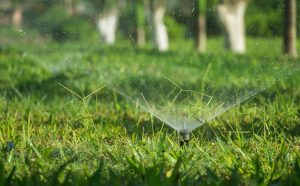How to Protect Your Lawn and Landscape from Wildlife Damage
Montana’s natural beauty includes a diverse array of wildlife—from deer and rabbits to voles and gophers—that can sometimes wreak havoc on well-maintained lawns and landscaping. While we value coexisting with local wildlife, it’s important to protect your property from damage that can occur year-round. At Horizon Landscape & Irrigation, we help Billings-area homeowners safeguard their outdoor spaces while maintaining harmony with the environment.
What Wildlife Is Causing the Damage?
The first step in preventing damage is identifying the culprit. Here are some of the most common offenders in Montana:
Deer: Known for munching on flower beds, vegetable gardens, and even shrubs.
Rabbits: Chew low-growing plants, bark, and seedlings.
Voles and Mice: Tunnel underground and damage root systems, especially during winter.
Gophers and Moles: Disrupt soil structure with mounds and tunnels, which can kill turf and create trip hazards.
Birds: May feed on berries, grass seed, or new garden sprouts.
Once you know what you’re dealing with, you can choose targeted solutions that are humane, effective, and suitable for Montana’s seasons.
Landscaping Choices That Discourage Wildlife
Believe it or not, smart plant selection can go a long way toward reducing unwanted visitors.
Deer-resistant plants: Try yarrow, Russian sage, lavender, and ornamental grasses that don’t appeal to deer.
Strong-smelling herbs: Rabbits tend to avoid rosemary, thyme, and chives.
Tough groundcovers: Replace vulnerable turf with low-maintenance, less appetizing groundcovers like creeping thyme or sedum.
You can also limit attractants by cleaning up dropped fruit, securing trash bins, and avoiding fertilizer blends with high nitrogen, which can stimulate the tender new growth deer love.
Physical Barriers That Work
Sometimes, the best way to protect your landscape is with a bit of creative fencing or netting:
Deer fencing: Install tall (6–8 foot) wire or mesh fencing around gardens and valuable plantings.
Tree wraps: Use plastic guards or mesh around young trunks to prevent gnawing from rabbits and voles in winter.
Raised beds: Help protect vegetable gardens from rabbits and gophers.
Underground barriers: For gophers or voles, bury mesh below the soil line in garden beds or around plant roots.
Snow cover in winter can help small critters access plants they wouldn’t otherwise reach, so winter-proofing your yard with protective wraps and early clean-up is critical in the fall.
Repellents and Deterrents
Natural repellents—like predator scents, garlic oil sprays, or motion-activated sprinklers—can effectively discourage wildlife if used consistently. Here are some options:
Scent-based sprays: Apply to susceptible plants; must be reapplied after rain.
Motion-sensor lights or noise makers: Useful for nocturnal visitors like deer.
Ultrasonic devices: Some homeowners find success deterring smaller animals with these, though results vary.
Keep in mind that animals may become accustomed to a single method over time, so rotating deterrents is often more effective.
Lawn Protection During Winter
Montana winters can be especially rough on turf, thanks to tunneling from voles beneath snow and ice. To protect your lawn:
Mow before winter: Keep grass short in fall to reduce cover for rodents.
Use vole repellents: Apply granular repellents around the perimeter of your lawn.
Avoid heavy mulching: In areas with vole problems, deep mulch beds can harbor pests.
A spring inspection can help catch damage early and prevent further spread.
Professional Help When You Need It
If wildlife is repeatedly damaging your lawn or landscape despite your best efforts, it may be time to bring in expert help. Horizon Landscape & Irrigation offers:
Wildlife damage assessments
Custom landscape design with deterrence in mind
Barrier installations and ongoing seasonal maintenance
We tailor solutions to your property’s unique challenges—always with Montana’s climate and local ecosystems in mind.
Enjoy Nature—Without Letting It Take Over
Wildlife is part of what makes living in Montana special, but that doesn’t mean you have to surrender your yard. With thoughtful planting, smart barriers, and seasonal adjustments, you can protect your landscape from damage and enjoy a thriving, well-balanced outdoor space.
Need help creating a wildlife-resistant landscape? Reach out to us at https://horizonlandscapemt.com for a consultation. We’ll help you strike the perfect balance between beauty, sustainability, and protection.
Read Next: When and How to Prune Trees and Shrubs in Montana




